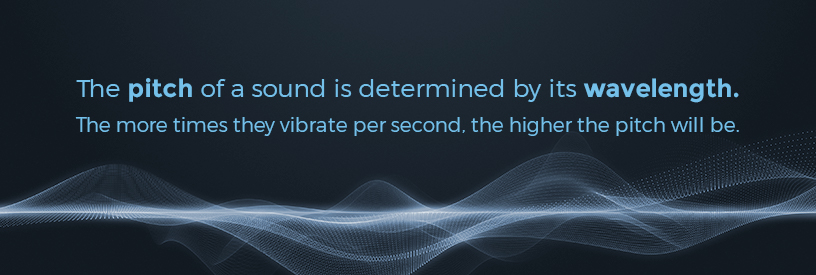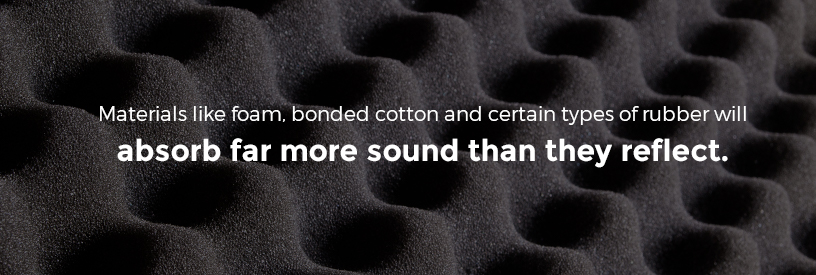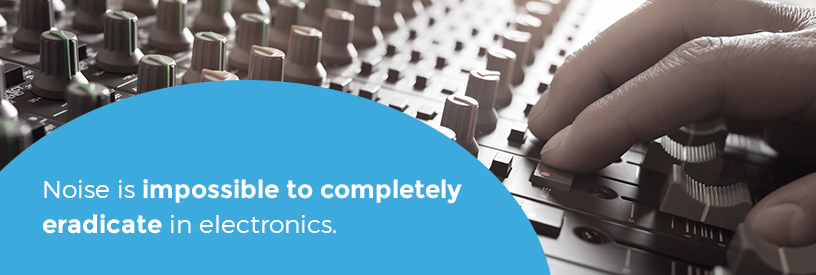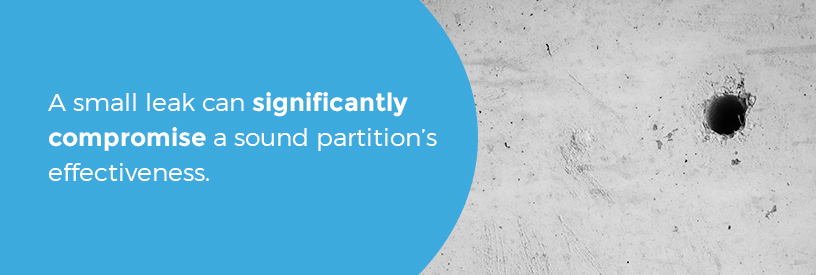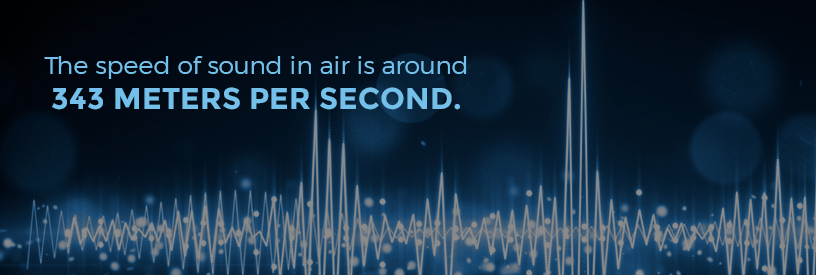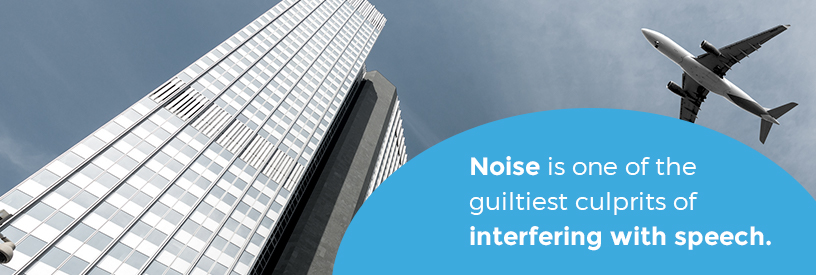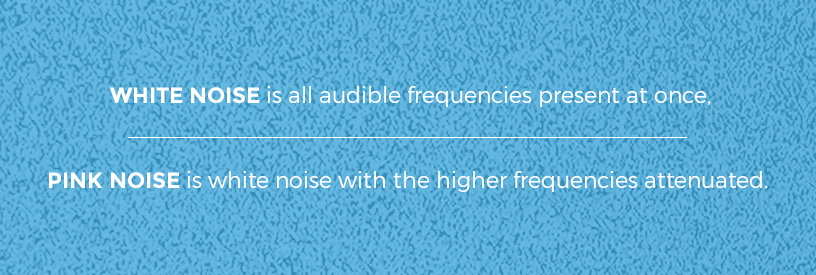
We enjoy sound. We take our cues from it and rely on it — and to capture it, there are even two cartilage receivers that come standard with our heads.
But what is sound? What is it made of? How can something like soft, bonded cotton or a layer of foam provide sound absorption, while a pane of solid glass does not absorb it as well?
The short answer is that sound is a vibration propagating through the matter surrounding us. These vibrations can be transmitted through solids, liquids and gases, such as squeaking floorboards, water and air.
What Causes Sound?
To create sound that is audible to human ears, sound energy moves the molecules of the substance through which it is traveling and creates sound waves that spread in a circular pattern like ripples in a pond. As sound waves move further away from their source, their intensity naturally becomes less intense.
Sound is a lot like water. It doesn’t have a shape or form, so it molds itself to its surroundings and, like water, can be absorbed by some materials and contained by others. This is why sound absorbing and soundproofing materials can stop the transfer of sound within a space, or from one space to another.
We will take a look at what sound is and how the absorption of sound really works, including some useful information on things like the sound absorption coefficient, equal loudness contour and the inverse square law sound follows so dutifully. But before we get to effective means of sound wave absorption, let’s learn where sound comes from and how it travels.

Propagation of Sound
To begin this journey into the world of sound, you are going to reimagine the world around you. First, envision the air surrounding you right now. It is made of trillions upon trillions of lightly dancing molecules floating through empty space. Anything solid — desks, walls, countertops — is also made of atoms and molecules, except they are more densely packed and less free to move about.
All of this is a medium for sound propagation. That means that if something disturbs one of those molecules by moving it fast enough, that molecule is going to bounce into the next molecule, which will bounce into the next molecule, which will bounce into the next molecule … you get the picture. It is like a microscopic domino effect.
Anything that makes a sudden sound is naturally going to move more than one molecule, though — it will move all of the molecules surrounding it. Much like ripples from a rock thrown into a pond, it travels in all directions away from the source of the disturbance.
To illustrate, snap your fingers. The very instant your skin slaps against itself, a shockwave is born. Because you live in three-dimensional space, the domino effect propagates outward in a sphere — not a circle, as with the pond’s ripples — with each molecule impacting the next until the disturbance eventually reaches your ears. At that point, the shockwave travels down your ear canal and affects your eardrum, which vibrates and relays the information to your brain.
There are a few things to note here:
- Sound moves as a longitudinal wave. That means the molecules will move outward with the shockwave, but they will return to their starting position afterward. There is no net movement of the molecules — that’s why sound doesn’t cause wind.
- The speed of sound is determined not by the loudness or pitch of the sound. Rather, it is determined by the air’s physical properties. Things like air density, pressure and temperature all play a role in the speed of sound.
- Not all sound moves in a spherical direction. Sound can be directed in one direction as well.
Wavelength and Loudness
The pitch of a sound is determined by its wavelength. Remember those vibrating air molecules? The more times they vibrate per second, the higher the pitch will be. If they vibrate more, they are said to have a shorter wavelength. To use the analogy of ocean waves, this is the distance from the crest of one wave to the crest of the next.
A sound wave whose air molecules wiggle back and forth ten thousand times per second — or 10,000 Hertz (Hz), to use the scientific unit — will sound unpleasantly shrill, like a dog whistle. On the other hand, a sound wave vibrating at only 30 times per second will be an earthquake-like rumble that you feel as much as hear. This type of sound has a much longer wavelength and, consequently, a higher rate of vibration.
Loudness is not related to wavelength. Nails on a chalkboard may seem louder than a person humming at the same volume, but they are not — the loudness is caused purely by the strength of the soundwave, otherwise known as its amplitude. Imagine this scenario:
- You are sitting down and a soundwave of 41 hertz passes by you. Forty-one Hz is the pitch of the lowest bass note in Queen’s “Another One Bites the Dust,” by the way.
- For the sake of our example, you can see the tiny air molecules wiggling back and forth — and, naturally, they wiggle back and forth 41 times per second.
- Now the volume is turned up. Those air molecules still wiggle back and forth 41 times each second — the only difference is that now, they wiggle farther to the left and right each time. This creates loudness.
Equal Loudness Contours
To make some sense of the psychoacoustic perception of “loudness,” scientists have come up with an interesting bit of research. By presenting test subjects with tones of varying pitch to see which ones they consider to be of equal volume, scientists have collected data and averaged it in a chart known as the Equal Loudness Contour.
Recall that people’s perception of loudness relates to factors other than decibels. In fact, things like pitch, character of the soundwave, bandwidth and length of time exposed to the sound all influence the perception of volume.
The practical takeaway of equal loudness contours is that we perceive some sounds to be louder than others. A distorted guitar, for instance, may sound louder than an acoustic guitar at equal sound pressure levels due to the complexity of the sound wave.
Sound Level Vs. Perception of a Sound’s Loudness
How we perceive sound, like many things associated with human psychology, is a strange and murky world that is not completely understood by scientists. We often swear certain sounds, which can be scientifically demonstrated to be the same volume as others, are louder. It plays on each person’s unique cocktail of perception and psychology. It’s confusing.
But here’s what we do know. Sound does have an objectively observable amplitude, and psychoacoustics do correlate somewhat with it.
Sound level is measured in decibels, abbreviated dB. Decibels operate on a logarithmic scale, not a linear scale. In practice, this means that an increase in 10 db will roughly sound twice as loud — hence, a food blender at 80 dB will actually sound twice as loud as a vacuum cleaner at 70 dB. Our hearing is easily damaged by long exposure to sound levels higher than this.
Inverse Square Law
So if sound is a domino effect, why doesn’t it go on propagating forever? The answer is that a sound wave starts with a given amount of energy and does not gain more as it travels. In fact, it only loses energy over time. As the sound propagates outward, think of that spherical shockwave growing and growing in size. Because the same amount of energy is now spread over a much larger spherical surface, it is naturally less intense — much like the heat from a campfire, which rapidly disappears as one walks farther away.
It turns out that the intensity of sound drops proportionally to the inverse of the sphere’s volume. In plain English, that means that it drops off dramatically — roughly to the tune of one over the distance squared.
To illustrate, snap your fingers again, this time about 6 inches from your ear. Note that this experiment works best outdoors, where there are no walls to reflect sound back at you. If you now snap 12 inches from your ear, or twice as far, the sound is one-fourth as loud. If you move 18 inches, or 3 times as far, the sound drops to one-ninth its initial loudness.
Sound Absorption
The majority of Soundproof Cow’s mission lies in the field of sound absorption. This phenomenon is exactly what it sounds like — taking incoming sound and absorbing it to achieve silence.
The tricky part of sound absorption goes back to the beginning of the article, where we talked about sound waves and vibrating molecules. When sound travels through one medium and passes into another, such as from the air into a solid surface, part of the sound wave is inevitably reflected back through the air. That’s why you can hear yourself so much better indoors: the walls reflect your own voice back at your ears.
Proper sound absorption minimizes this reflection. Materials like foam, bonded cotton, fiberglass and certain types of rubber will absorb far more sound than they reflect. The materials are also extremely resistant to sound transmission, so once inside the material, the sound wave is deadened quickly and effectively.
Speech Intelligibility
Our ears are more powerful instruments than we often give them credit for. They are capable of taking in a huge amount of information — every sound frequency roughly between 20 and 20,000 Hz — and processing it, translating it to brain signals, and sending it to our CPUs to do what we will with them, all in a fraction of a second.
As social creatures, we are highly sensitive to the nuances of speech. The human voice is a hodgepodge of distinctive frequencies as unique as a fingerprint, and we rely on hearing all of them to make sense of what is being said and how it is intended.
When we are unable to hear certain frequencies, we start to lose our ability to comprehend what is being said. As we shall see, background noise can play a large part in this problem.
Signal to Noise Ratio
When there is a sound we want to hear or record, we are at battle with the surrounding noise that threatens to sonically eclipse it. Ideally we want a high signal-to-noise ratio — that is, a good amount of signal to a low amount of noise.
In a room with 50 dB of background noise, a person speaking at 60 dB may be difficult to understand. That’s because the 50 dB of noise — which we call the “noise floor” due to it being the baseline level of quiet in the room — is competing with the 60 dB voice for frequencies.
The noise floor is present not only in the ambient environment around us but also in every electronic audio device we own. Much like friction in physics, noise is impossible to completely eradicate in electronics — every wire, amplifier and other piece of circuitry adds some noise. Furthermore, the noise floor cannot be removed by simply turning up the volume, as this will raise the noise floor by the same amount.
Ambient Sound Level of Background Noise
The sounds that are constantly in the background of our lives create a low hum that our brains are pretty good at canceling out. That’s why that ticking clock on the wall doesn’t drive you crazy — sorry for mentioning it and making you realize it now, though.
The sound level of ambient background noise changes with location. In urban areas, ambient background noise can range from 60 dB to higher than 80 dB, or roughly from the sound level of an office environment to the roar of a jet 3 miles overhead. In suburban areas, however, the ambient sound level typically ranges from 45-50 db.
One interesting note, though. If you think you might like having zero background noise, think again. A room with absolutely no background noise can send even the most meditative minds running back to the chaos of the real world. One room, which has been scientifically designed to block out 99% of all background sounds, has never seen a visitor stay longer than 45 minutes. They tend to go mad when all they can hear is their own heartbeat, their own stomach gurgling, even the blood pumping through their veins.
All things in moderation. Reducing ambient background noise in your everyday life is an excellent way to claim your personal space and make room for the sounds you love, such as music, entertainment and even silence.
The Effects of Sound Leak on Partition Sound Insulation
Imagine you have soundproofed an entire wall of your house to keep noise from the street out. Everything is ready to go except for that one crack under the door — but that can’t let that much noise in, can it?
It turns out that a small leak can significantly compromise a sound partition’s effectiveness. That’s why it is important to finish the job with door seals and sweeps, which can save your soundproofing job and keep things nice and quiet.
Adding Decibels
Remember when adding decibels, small increments such as +3dB or -3dB can create noticeable differences in volume. Those who mix music professionally know this best — if a little more of something is needed, they will typically only dial it up a couple of decibels.
The amount of power a sound has increases massively as you move up the decibel scale. For instance, imagine a sound is played. If another sound is played at the exact same power, the difference between them is 0 dB. However, let’s say the sound played with a million times more power. This is only 60 dB higher.
Noise Reduction Coefficients
Let’s imagine we clap our hands in front of a thin, wooden wall. The sound wave will travel through the air and strike the wall. Part of the wave will bounce back at us, and the other part will be transmitted through the wall to the other side. Because wood is rigid and prone to vibration, lots of sound will transmit through it, and not much will be absorbed.
To be a good absorber, a material needs to have a high absorption coefficient. This number is between 0 and 1, with 0 being a perfect transmitter and 1 being a perfect absorber. Materials like wood, glass and paper have low absorption coefficients, while studio foam and soundproof insulation have coefficients closer to 1.
Speed of Sound
As we stated before, the speed of sound is independent of wavelength or sound amplitude — it has to do entirely with the properties of the medium the sound is passing through.
The speed of sound in air is around 343 meters per second. This varies with temperature, wind and humidity, but it is a reliable rule. Sound is transmitted by one air molecule hitting another, and so it would make sense that the speed of sound is faster in liquids and solids than in gases. The molecules are right next to one another, and so they have less distance to travel to transmit the sound than they do in gases.
What Is Noise?
Noise is defined as any music you don’t like. No, that’s a lame joke — but there is a kernel of truth in there as well.
In scientific and electronic applications, noise is the presence of unwanted energy or signals that degrade the clarity of data. It can come from many sources — machinery, electrical interference and ambient background radiation, to name a few. Instead of just seeing the result, the sought-after data is usually sitting in a sea of background noise that must be filtered out.
Back to our lame joke. Sonic noise is not much different. There are sounds we want to hear and sounds that are inevitably going to reach our ears whether we like it or not — and this latter category is what is known as noise.
It comes in the form of:
- Passing cars
- Electrical appliances
- Airplanes flying overhead
- The neighbor’s television
- Barking dogs
- Air conditioning
- Rain on the rooftop
- Wind against the windowpanes
The very essence of sound absorption, which is the heart of Soundproof Cow’s mission, is absorbing noise so you may fill your life with the sounds you want.
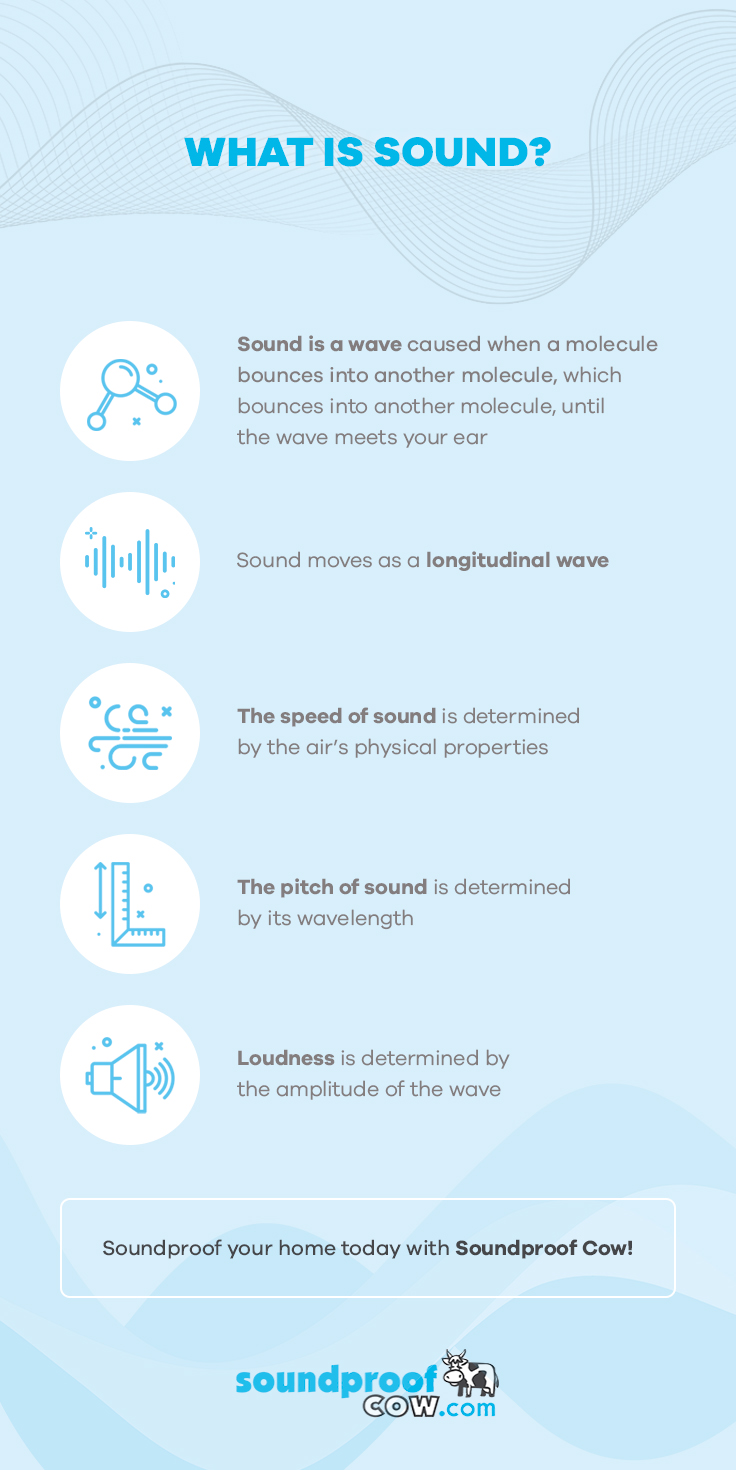
Noise Reduction
When we cannot hear each other, we tend to speak louder to compensate, which is bad for our voices and our ears alike. This is one reason reducing ambient background noise is so important. For those of us who need silence to do work — such as studio engineers, musicians and many others — it is also a professional necessity.
This is where Soundproof Cow shines through. We specialize in noise reduction. Our insulating foam and other products trap noise and bring it as close to a halt as possible before reaching your ears. By reducing the noise, we help you create a quiet home, workspace or studio.
Noise Interference With Speech Communications
Human speech covers a wide range of frequencies. A female voice usually hits frequencies between 350 Hz and 17,000 Hz, and a male voice ranges between 100 Hz and 8,000 Hz. A staggering number of these frequencies are at play simultaneously when speaking, and when we start to lose the ability to discern them, speech becomes less intelligible.
Noise is one of the guiltiest culprits of interfering with speech. Ambient background noise effectively bombards our ears with all kinds of frequencies, and the result is that it hogs the ears’ signal processing and crowds out the frequencies we want to hear.
For example, the letter “s” has a frequency in mid-thousands. If you are talking to someone and there is an air compressor being used somewhere nearby, you are likely hearing a lot of sound in the same register. The effect is that you will have trouble distinguishing when your conversation partner is saying an “s” because of the background noise.
Speech Directivity: Speaker and Listener Orientation
We are adapted to speak to each other face-to-face. This is not only because of our ability to read body language and facial expressions, but also because our voices naturally project straight out of our mouths.
When people listen to someone talking in a direction away from them, it is demonstrably more difficult to understand the speaker. When background noise interferes with speech communication, it is much more difficult to hear others unless they are directly facing you.
Speech Privacy
On the other hand, this effect can be turned on its head for privacy. When private conversations need to happen in crowded spaces, having a noise machine can effectively provide a hush that keeps conversations from spreading too far.
Masking Sound Systems
A masking sound system is a common tool for this. The speakers are typically not visible, and their noise is not very noticeable, but they will emit a soft “whooshing” sound similar to a breeze through leaves or an air system operating. This is often white noise or pink noise. White noise is all audible frequencies present at once, while pink noise is white noise with the higher frequencies attenuated. They are useful in:
- Open offices
- Hospitals
- Workplace applications
Transmission of Sound
Sound travels through the air, but it also travels very well — in fact, even better — through materials like solids and liquids. That’s because the atoms and molecules are more densely packed in solids and liquids. Each atom has to do less traveling to bump into its neighbor, and therefore information can be passed quickly between them.
However, sound also passes between different media. A sound wave passing through the air will inevitably hit something like a wall. The air’s pressure wave impacts the surface, transmitting some of its energy into it. The resulting wave then propagates through the wall and impacts the air on the other side. Though greatly reduced in power, the original sound is still discernible.
Resonant Frequencies
The subject of resonance is a fascinating one. With sound waves, it comes into play often. Let’s look at an example.
Imagine singing a steady, low note inside a room. The sound waves travel through the room and bounce off the wall, reflect back toward you, then bounce off the wall behind you and continue the pattern. The waves overlap one another as they pass back and forth, and if you hit exactly the right note, they could even coincide exactly in their placement and traverse.
That means the wave traveling toward the wall will push air at the exact same frequency as the wave traveling back over it. This causes a noticeable increase in volume at that particular note, which is termed the room’s “resonant frequency.”
Sound Transmission Class
The Sound Transmission Class (STC) is a rating of how well a partition blocks sound coming from the air. It is given to soundproofing partitions and is very useful in determining what will be effective.
Sound Isolation
If you wish to isolate a sound — that is, if you want to do something like recording a vocal track without any bleed-in from outside sounds — then you will need soundproofing materials. This is also useful for places like home theaters, lecture halls and conference rooms, where the sound in the room needs to be the only sound audible.
Sound isolation can be accomplished in several different ways. Whether it is through the use of dense insulation, specialized foam or some other substance, Soundproof Cow can help you move in the right direction.
Come to Soundproof Cow for Solutions to Sound Problems
Contact Soundproof Cow with any inquiries you may have about soundproofing. We provide complete acoustic analysis services, and you can fill out a soundproofing questionnaire to get specific help with your problem. Additionally, peruse our wide selection of products to begin taking control of your noise environment.
Learn More About Understanding Sound
What is Reverberation of Sound
Impact Noise vs Airborne Noise
How to Determine the STC Rating of a Wall

I just wanted to send a quick thank you for your rapid response and helpfulness. I very much appreciated it. You have been responsive in every way all through the process. It has been a pleasure doing business with you and your company.
- T. Alexander


